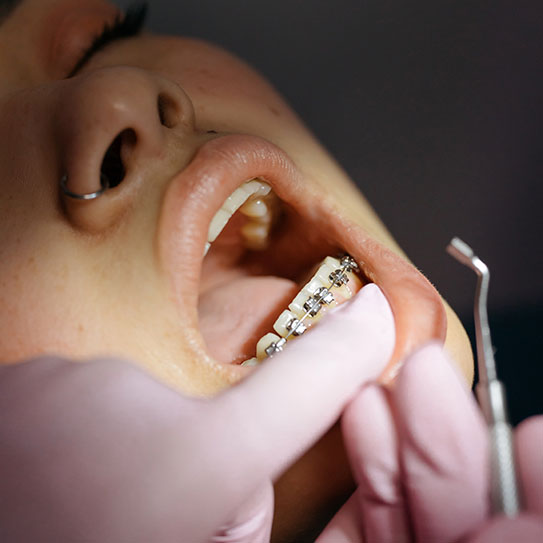A Complete Overview of the Braces Process
May 21st, 2025

Everything You Need to Know About Braces
Orthodontic treatment can be a transformative experience, offering both aesthetic improvements and long-term oral health benefits. For many individuals — both teens and adults — braces are the trusted solution for achieving a straighter, healthier smile. If you're exploring your options and wondering what to expect from the process, this complete overview is designed to guide you through every step. At Iritani Orthodontics, we provide the kind of personalized, high-quality care behind the braces Greenwood Village patients prefer.
Step 1: The Initial Consultation
Your journey with braces begins with a comprehensive consultation with an experienced orthodontist. During this visit, we’ll take digital X-rays, photographs, and sometimes 3D scans of your teeth and jaw. Your orthodontist will examine your bite, alignment, and oral health history to determine whether braces are the best course of treatment.
This is also a great opportunity to ask questions and discuss your goals. Whether you're dealing with crowding, spacing, bite issues, or general alignment concerns, your orthodontist will tailor a treatment plan to suit your specific needs. At Iritani Orthodontics, we believe in full transparency, so you’ll leave this appointment with a clear understanding of your treatment timeline, estimated costs, and what to expect throughout the process.
Step 2: Preparing for Braces
Before getting your braces placed, your orthodontist might recommend a few preparatory steps. This could include professional teeth cleaning, removing baby teeth or impacted teeth, or fitting spacers to create room between molars for bands. Preparing the mouth ensures that when it’s time to place the braces, everything goes smoothly.
Some patients may also undergo early orthodontic treatment or a two-phase treatment plan. These proactive approaches are especially useful for younger patients whose jaws and teeth are still developing. By addressing key issues early, we can often reduce the complexity or length of treatment later on.
Step 3: Placement of Braces
When it’s time to get your braces, expect a procedure that typically takes 1–2 hours and is completely pain-free. The orthodontist will begin by cleaning and drying your teeth. Next, brackets will be bonded to each tooth with a special adhesive, and archwires will be placed through the brackets and secured with elastic bands.
This is the moment when the braces Greenwood Village relies on are expertly fitted for optimal comfort and function. You’ll receive instructions on how to care for your braces and what foods to avoid (sticky or hard foods that can damage the brackets). It’s normal to feel some discomfort or pressure for a few days as your mouth adjusts to the new appliance.
Step 4: Regular Adjustments
Throughout the course of your orthodontic treatment, you’ll visit your orthodontist every 4 to 8 weeks for adjustments. During these appointments, your orthodontist will tighten or replace wires, change elastics, and monitor your progress. These regular checkups are essential to ensure your teeth are moving as planned.
Adjustments might cause mild soreness for a day or two, but over-the-counter pain relievers can help. These visits are also a chance to discuss any concerns and get feedback on how well you’re maintaining your braces.
Step 5: Maintaining Oral Hygiene
Proper brushing and flossing are essential when you have braces. Food particles can get trapped in brackets and wires, increasing the risk of plaque buildup, cavities, and gum disease. Your orthodontist will show you how to brush and floss effectively with braces and may recommend special tools like orthodontic brushes, floss threaders, or water flossers.
Maintaining regular visits with your general dentist is also critical during orthodontic treatment. Your dentist and orthodontist will work together to keep your teeth healthy and clean throughout the process.
Step 6: Removal of Braces
After months or sometimes years of consistent treatment, the exciting day will come — braces removal! Once your orthodontist confirms that your teeth have reached their ideal positions, they’ll carefully remove the brackets and wires. This appointment is usually followed by a thorough cleaning and sometimes digital scans for your retainer.
Many patients are surprised at how fast and easy the braces removal process is. And the best part? You’ll get to see your beautifully aligned smile for the first time without wires or brackets.
Step 7: Retention Phase
Your orthodontic journey doesn’t end the day your braces come off. To maintain your results, your orthodontist will provide a retainer. Wearing your retainer as prescribed is critical to preventing your teeth from shifting back to their original positions.
There are different types of retainers — removable, fixed, or clear aligner-style — and your orthodontist will help you choose the one that fits your lifestyle and needs. Retention is a lifelong commitment, but after the initial few months, most people only need to wear their retainers at night.
Trust the Experts in Greenwood Village
At Iritani Orthodontics, we take pride in providing the kind of expert care that makes us the provider of braces Greenwood Village patients trust. From the first consultation to the final retainer check, our team is here to support you every step of the way.
If you’re searching for “braces Greenwood Village,” you’ve come to the right place. We combine advanced technology, a warm and friendly environment, and decades of experience to ensure that your smile transformation is smooth, effective, and rewarding. Contact us today to schedule your consultation and take the first step toward the confident smile you deserve.




























